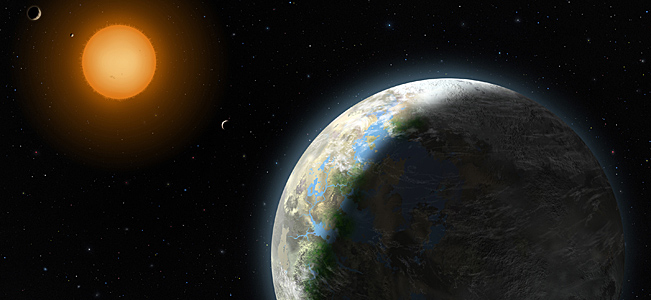Could 'Goldilocks' planet be just right for life?

AP Photo/Zina Deretsky, National Science Foundation
An artist rendering by Lynette Cook, National Science Foundation, shows the new planet on the right. More photos »
By SETH BORENSTEIN, AP Science Writer Seth Borenstein, Ap Science Writer –
Wed Sep 29, 9:23 pm ET WASHINGTON – Astronomers say they have for the first time spotted a planet beyond our own in what is sometimes called the Goldilocks zone for life: Not too hot, not too cold. Juuuust right.
Not too far from its star, not too close. So it could contain liquid water. The planet itself is neither too big nor too small for the proper surface, gravity and atmosphere.
It's just right. Just like Earth.
"This really is the first Goldilocks planet," said co-discoverer R. Paul Butler of the Carnegie Institution of Washington.
The new planet sits smack in the middle of what astronomers refer to as the habitable zone, unlike any of the nearly 500 other planets astronomers have found outside our solar system. And it is in our galactic neighborhood, suggesting that plenty of Earth-like planets circle other stars.
Finding a planet that could potentially support life is a major step toward answering the timeless question: Are we alone?
Scientists have jumped the gun before on proclaiming that planets outside our solar system were habitable only to have them turn out to be not quite so conducive to life. But this one is so clearly in the right zone that five outside astronomers told The Associated Press it seems to be the real thing.
"This is the first one I'm truly excited about," said Penn State University's Jim Kasting. He said this planet is a "pretty prime candidate" for harboring life.
Life on other planets doesn't mean E.T. Even a simple single-cell bacteria or the equivalent of shower mold would shake perceptions about the uniqueness of life on Earth.
But there are still many unanswered questions about this strange planet. It is about three times the mass of Earth, slightly larger in width and much closer to its star — 14 million miles away versus 93 million. It's so close to its version of the sun that it orbits every 37 days. And it doesn't rotate much, so one side is almost always bright, the other dark.
Temperatures can be as hot as 160 degrees or as frigid as 25 degrees below zero, but in between — in the land of constant sunrise — it would be "shirt-sleeve weather," said co-discoverer Steven Vogt of the University of California at Santa Cruz.
It's unknown whether water actually exists on the planet, and what kind of atmosphere it has. But because conditions are ideal for liquid water, and because there always seems to be life on Earth where there is water, Vogt believes "that chances for life on this planet are 100 percent."
The astronomers' findings are being published in Astrophysical Journal and were announced by the National Science Foundation on Wednesday.
The planet circles a star called Gliese 581. It's about 120 trillion miles away, so it would take several generations for a spaceship to get there. It may seem like a long distance, but in the scheme of the vast universe, this planet is "like right in our face, right next door to us," Vogt said in an interview.
That close proximity and the way it was found so early in astronomers' search for habitable planets hints to scientists that planets like Earth are probably not that rare.
Vogt and Butler ran some calculations, with giant fudge factors built in, and figured that as much as one out of five to 10 stars in the universe have planets that are Earth-sized and in the habitable zone.
With an estimated 200 billion stars in the universe, that means maybe 40 billion planets that have the potential for life, Vogt said. However, Ohio State University's Scott Gaudi cautioned that is too speculative about how common these planets are.
Vogt and Butler used ground-based telescopes to track the star's precise movements over 11 years and watch for wobbles that indicate planets are circling it. The newly discovered planet is actually the sixth found circling Gliese 581. Two looked promising for habitability for a while, another turned out to be too hot and the fifth is likely too cold. This sixth one bracketed right in the sweet spot in between, Vogt said.
With the star designated "a," its sixth planet is called Gliese 581g.
"It's not a very interesting name and it's a beautiful planet," Vogt said. Unofficially, he's named it after his wife: "I call it Zarmina's World."
The star Gliese 581 is a dwarf, about one-third the strength of our sun. Because of that, it can't be seen without a telescope from Earth, although it is in the Libra constellation, Vogt said.
But if you were standing on this new planet, you could easily see our sun, Butler said.
The low-energy dwarf star will live on for billions of years, much longer than our sun, he said. And that just increases the likelihood of life developing on the planet, the discoverers said.
"It's pretty hard to stop life once you give it the right conditions," Vogt said.
Reposted From Associated Press


 Email
Email








